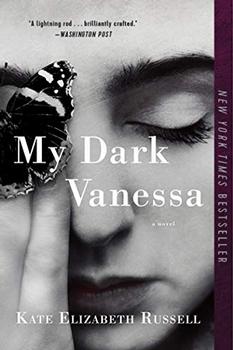Summary | Excerpt | Reviews | Beyond the Book | Read-Alikes | Genres & Themes | Author Bio

A Novel
by Kate RussellThis article relates to My Dark Vanessa
 In My Dark Vanessa by Kate Elizabeth Russell, a much-older teacher begins his seduction of 15-year-old Vanessa Wye with poetry. One of the works he uses to draw her in is the 1962 Vladimir Nabokov novel Pale Fire. Specifically, a section of verse describes how a fictional poet, John Shade, met his wife on an outing to New Wye Falls. Shade goes on to proclaim his continued love for her over the years, comparing her to a butterfly (Nabokov was himself a known butterfly enthusiast) called a Vanessa, a.k.a. the Vanessa atalanta or Red Admiral, in line 270:
In My Dark Vanessa by Kate Elizabeth Russell, a much-older teacher begins his seduction of 15-year-old Vanessa Wye with poetry. One of the works he uses to draw her in is the 1962 Vladimir Nabokov novel Pale Fire. Specifically, a section of verse describes how a fictional poet, John Shade, met his wife on an outing to New Wye Falls. Shade goes on to proclaim his continued love for her over the years, comparing her to a butterfly (Nabokov was himself a known butterfly enthusiast) called a Vanessa, a.k.a. the Vanessa atalanta or Red Admiral, in line 270:
Come and be worshiped, come and be caressed,
My dark Vanessa, crimson-barred, my blest
My Admirable butterfly! …
The instructor points out the obvious parallels to his young pupil, and recites the romantic sections to her to lure her into becoming his lover.
Pale Fire is considered a prime example of metafiction due to its unusual structure and premise. On the surface, it's a volume of poetry (composed by Shade, as mentioned above) with an introduction, commentary and extensive index compiled by Shade's neighbor, Charles Kinbote. Kinbote has obtained Shade's manuscript after the latter's murder and taken it upon himself to publish and annotate the work. His comments, which come after the poem and make up the second half the of book, becoming increasingly unhinged; he imagines a mythical kingdom of Zembla ruled by the equally imaginary Charles II. As Kinbote's narrative proceeds, it seems more and more possible that he's delusional and believes himself to be the king living in a state of exile, although he never explicitly states this.
That brief description belies the incredible complexity of the novel. The poem itself is actually quite lovely, although many readers dismiss it as something to simply get through because Kinbote's commentary is so bizarre and intriguing—drudgery one must endure before getting to the good stuff. Kinbote's annotations, though, are what spark continual debate between readers and scholars alike. Has Kinbote murdered Shade? Does he truly believe himself to be the hidden ruler? Is he actually insane or is he just trying to appear that way? The questions are numerous with no clear answers, although they have provided fodder for a multitude of analytical papers since the book's debut.
When Pale Fire was published, critical reaction ran the gamut, with some lauding the work as genius while others considered it nonsensical and overly contrived. The assessments haven't changed much over the decades, with readers divided into both camps—some loving it, others despising it. Overall, though, Pale Fire is considered a masterpiece, and it appears on several "best of" lists, such as Peter Boxall's 1001 Books You Must Read Before You Die, Time magazine's 100 best English-language novels published since 1923 and the Modern Library 100 Best Novels list.
Butterflies from Vladimir Nabokov's collection in the Nabokov Museum, Saint Petersburg, Russia
Filed under Books and Authors
![]() This "beyond the book article" relates to My Dark Vanessa. It originally ran in March 2020 and has been updated for the
February 2021 paperback edition.
Go to magazine.
This "beyond the book article" relates to My Dark Vanessa. It originally ran in March 2020 and has been updated for the
February 2021 paperback edition.
Go to magazine.
Your guide toexceptional books
BookBrowse seeks out and recommends the best in contemporary fiction and nonfiction—books that not only engage and entertain but also deepen our understanding of ourselves and the world around us.